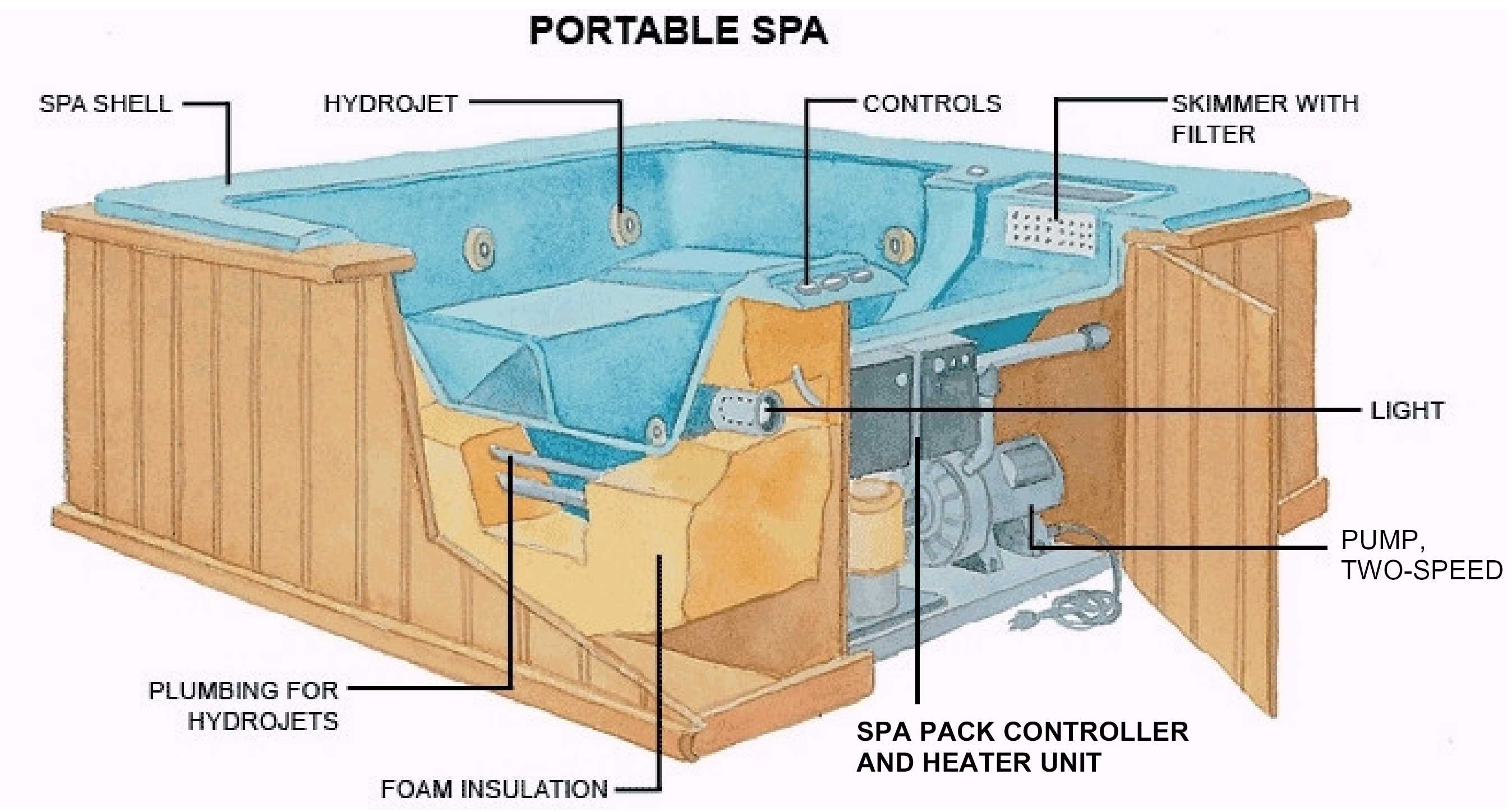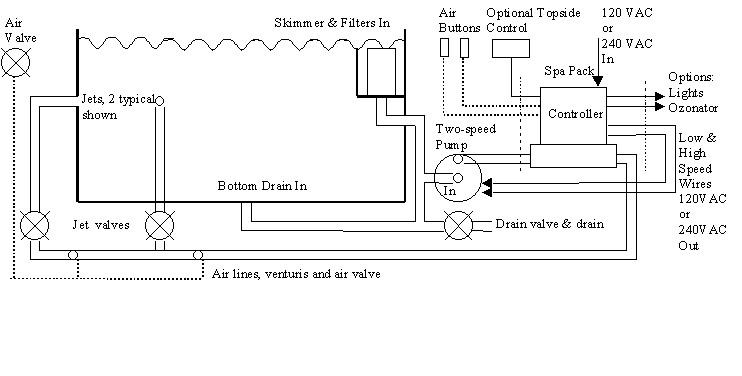|
This short primer on how the various components of a portable hot tub work together is brought to you by
the SPA GUYS mobile repairs and service in Washington. We hope you find this information useful and consider us when your spa or
hot tub needs attention.
WARNING: THIS INFORMATION IS PRESENTED FOR REFERENCE ONLY. ANY EQUIPMENT CAN BE HAZARDOUS. READ, UNDERSTAND AND FOLLOW ALL MANUFACTURERS AND OTHER SAFETY WARNINGS.
Hot tubs can, and usually do, have slight differences.
For example the filter could be on the output (pressure) side of the pump rather than the input (suction) side.
However the essential operations are identical.
All hot tubs combine the same basic mechanical structure to contain the water and equipment as well as the same basic equipment to perform the same operations on the water.
We will use the terms spa, portable spa and hot tub interchangably.
Shell
The shell is designed to contain the water, provide mounting points for jets and also usually has various seats molded into it.
The hot tub surface, or shell, is typically made of acrylic or another weather and chemical resistant thermoplastic.
The shell is reinforced or supported with either fiberglass backing, high density polyurethane foam or some combination of the two to enable the hot tub to withstand the weight of the equipment, water and bathers.
Cabinet
The cabinet is designed to provide structural support for the shell and equipment and also to conceal the somewhat unsightly equipment itself.
The cabinet will also have a door of some type that allows you to access the equipment.
Traditionally wood, now weather resistant polymer, today's cabinets are both attractive and easy to maintain.
The cabinet houses all plumbing, pumps, heaters, etc., making the unit "self-contained" and "portable."
Pumps
One or more pumps are used to circulate the water in and out of the hot tub.
There are two distinct functions performed by the pumps, filtering and operating the jets.
Because of this even a hot tub with only one pump will have connecting wires on the pump and controls that provide two separate speeds, low speed for filtering and high speed for operating the jets.
Low speed operation is controlled by the spa pack based on the thermostat and timeclock, if one is present.
There is often more than one control scheme selected by a mode switch on the pack.
When filtering the pump typically draws water through the filters and then pushes it through the spa pack consisting of the heater and controller together.
Even though a smaller pump, or a lower speed, is used most heating and filtering is accomplished in this mode since the spa runs in this mode far longer than in high speed with the jets operating.
As a rule of thumb a hot tub should run from 2 to 4 hours per day to provide adequate filtering.
If you have a 240VAC heater and rely only on thermostat control your spa may heat up so quickly that the pump shuts off without adequate filtering taking place.
In this case using a spa pack with a timeclock and a mode that allows the timeclock to drive the low speed pump will provide adequate filtering.
Most 120 VAC hot tubs run long enough while heating to provide adequate filtering.
When operating in high speed pumps force a large volume of water through tiny jet nozzles on the surface of the hot tub, creating high pressure streams.
The number of pumps is proportional to the size of the unit, the number of jets and the degree of therapy delivered.
High speed operation is controlled by the spa pack using an air button.
Blowers
On some hot tubs, particularly older units, special air blowers may be used to create additional bubbles in the water.
These can be used instead of or in addition to the typical air venturis that passively draw air into the jets water supply.
If present blowers are controlled by the spa pack using an air button.
Jets or Hydrojets
The water stream generated through the pump action pulls air through each jet with Venturi action.
The air and water mix, creating bubbles that massage the body as they break against the skin to alleviate pain and muscle soreness.
The jet is just a nozzle and the air is drawn in through a venturi that creates a suction action on an air line that is normally connected to a valve to allow air bubbles to be turned on and off.
The jets themselves are often connected to one or more valves to allow different combination of jets to be turned on or off at one time.
Spa Pack: Controller and Heater
The spa pack contains a controller and heater in one unit.
The controller is designed to safely allow the filter, pump, heater, and jets to efficiently provide the functions of filtering, heating and therapeutic water jets.
We will look further into the controller later. The heater uses and element like a home hot water tank (however they are NOT the same).
As the water circulates through the hot tub, it is warmed by the heating element in the heater but only by a certain amount each time the water passes through the heater.
The spa pack controller also performs miscellaneous functions like turning the lights on and off or providing power for an ozonator.
Topside (or Spaside) Control
The control pad allows bathers to change water temperature from inside or outside the hot tub.
The water in a hot tub should never exceed 104 degrees Fahrenheit, which is the maximum temperature sanctioned by the Consumer Product Safety Commission.
If children or adult bathers are using the tub for prolonged periods of time, the water temperature should be kept at 98 or 99 degrees.
The control also provides air buttons that allow the user to turn the pumps, lights or blowers on or off.
Filters/ Sanitation system
The hot tub's filter plays a role in keeping the water clean and clear, as do the chemicals that are added on a routine basis.
The filters are typically located in a filter area accessible from the top of the hot tub itself and consist of one or more screw in filters with a strainer or skimmer.
If one filter is noticeably dirtier than the others it is probably connected to a separate low speed circulation pump and is doing most of the filtering.
Ozonator
An Ozonator uses a special light to generate ozone which is injected into the spa through a venturi, similar to but smaller than the venturis used to inject air into the jets.
The ozone functions similar to chlorine or bromine in destroying organic material and thus can lessen, but does not eliminate, the need to add chemicals to the water.
The ozonator is usually controlled by the spa pack and is turned on whenever the low speed pump is operating.
Lights
The lights in a hot tub provide a more pleasant environment especially at night and also provide illumination for operating the spa controls.
There are various types of incandescent and the new LED lights which can be either white or various combinations of colors.
The new LED lamps can also switch colors following a preset program selected by the user.
Most lights operate on 12 volts which is supplied by the spa pack or by a separate transformer mounted with the rest of the equipment.
The lights are controlled by an air button on the top surface of the hot tub.

Notice the equipment area and access door. This is a typical setup but will vary slightly from hot tub to hot tub.
Also notice how the insulating and structural foam covers nearly the entire space between the cabinet and the shell.
This means most of the plumbing is embedded in foam and if there is a leak or other repair to the plumbing or jets the foam must be carved away to expose the parts.
Considering how the hot tub and equipment works and looking at the picture above we see that various combinations of equipment perform various functions.
Many parts of the hot tub are used for more than one function. Listing all the functions will allow us to trace out the path through the equipment used to perform that function.
Hot tub functions
Drain and fill: Gravity fed drain and valve, usually with a hose connection
Filtering: Skimmer and filter, low speed pump, jets, spa controller, heater can be on or off
Heating: Skimmer and filter, low or high speed pump, spa controller with heater on
Jets: Skimmer and filter, high speed pump, air venturis, air valve, hydrojets, spa controller, heater can be off or on
Lights: Light, spa controller, air button
Ozone injection: Ozonator, spa controller, venturi for ozonator connection
Freeze protection: Skimmer and filter, low speed pump, spa controller with heater on
Blower operation (not shown): Blower on, jet pump can be on or off, filtering/heating can be on or off
Note that on 120VAC hot tubs the heater is turned off by the controller when the jets are on and the pump is running at high speed in order to remain below the available 20 amp power.
Hot tubs connected to 240VAC can heat when the pump is running at low or high speed.
Also 120VAC hot tubs usually do not have additional pumps or blowers although the are sometimes encountered.
Now that we understand the basic equipment and its functions lets look at a block diagram of a typical hot tub.
With minor adjustments this diagram covers all portable hot tubs.
Note how each function is performed by some path through some combination of equipment.
Blowers or more pumps can be added but the basic functions remain the same.
Sometimes the position of the filter, pump or heater is changed but there is always a continuous loop running from the spa through the equipment and back to the jets.

Equipment voltages
Be sure your electrical power is off and disconnected and all user manual instructions for your spa are followed when opening the equipment area.
The pump, ozonator, and blower all require the correct voltage from the controller in the spa pack to function.
(The light usually requires a special low voltage of 12VAC).
Additionally the heater and internal components in the spa pack itself require the correct voltage to operate.
120VAC spa packs can only operate 120VAC equipment. 240VAC spa packs can operate either 120VAC or 240VAC equipment.
For this reason if you're spa pack is hooked up to a 240VAC 4-wire service (2 hot wires, a neutral wire, and a ground) you can not assume your pump is 240VAC.
On a spa pack which is supplied with 240VAC the voltage for each piece of equipment can be changed within the spa controller from 120VAC to 240VAC or vice versa.
The best way to insure you know the correct voltage for your pump(s), blowers, ozonators and lights is to read the nameplate voltage.
Common voltages are: Pumps: 120VAC or 240VAC are common. Ozonators: 120VAC are most common.
Lights: 12 volts (low power) are most common. Blowers: 120VAC or 240VAC are common.
|
